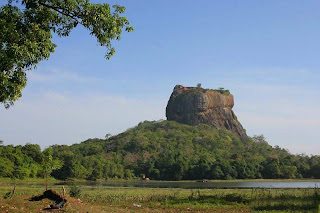`인도`에 가면...꼭 한번 `시리 빠다`를 찾아봐~~
빵에 발라먹는 버터 이름이냐구...?
건.. 아니구~~
암튼... `시리빠다`는 흔한 것이 아니라서...
그걸 찾으려면.. 다리품을 쎄게 팔아야 혀~~
자자... 그러니까 일단 들어 봐..
일단 인도 남쪽으로 몇날 몇일을 잊어버리고 쭉~~ 가...!!
그러면 이 거대한 대륙의 끝이 나오고...
그 대륙의 뾰족한 끄트머리에는..
저만치..똥 덩어리같은 게 바다 한 가운데에 떨어져 있어...
보여..?
응.. 온갖 수단을 다 동원하여... 거길 건너가라고...
거기가...말로만 듣던 `시리 랑카`라는데야...
어~~ 거기서 알만한 사람에게.. `시리빠다`가 어딧냐고 물어 봐~~!
그러면... 요리조리해서 섬 가운데 있는 깊은 산속으로 들어가라고 할꺼야...
섬 가운데 있는 고원에서 남쪽으로 위치해있는데...
그 곳에 있는 `라뜨나뿌라`시에서 접근한다면.. 동북방으로 100리쯤 가야 하지~~
거기서..눈을 쳐들어 보면... 시야를 가리는 봉우리가 하나있어...!
편평한 주변의 숲위로 불룩하게 쌓여있는 것이..
꼭.. 누구 엉덩이에서 방금 탈출한 똥덩어리처럼 생겼지 ...
허억~~ 저게 바로 `성스러운 발`이라는 뜻을 지닌 `시리 빠다`...
부처님의 발자욱이 쿡~ 찍혀있다는 그 봉우리~~
고거참 .. 냄새나게 생겼다....
!@#$%
오마니~~ 여그가 `시리빠다`랍네다~~~
그러나.. 시리빠다 가는 길을 만만히 보지 말라구~~
드넓은 열대 원시림에다가... 코끼리.. 호랑이 같은 온갖 맹수들이 득시글거리거든...
그리고 눈떠도 소용없는 안개로 유명한 곳이라서 말이야~~
몇시간이나 껄덕거리면서.. 빙빙 돌아올라가는 길은 멀기만 하지...
비에 질벅거리고..... 발은 연신 미끄러지지...
하도 긴장을 혀서 몸은 후달리고.. 식은 땀이 비에 섞여 흐르지...
그런데다가..질긴 바람은 이리오라고 허공으로 자꾸 잡아당기지...
짙은 안개로 내딘 걸음이 허공인지.. 길인지 당체 알 수가 없지...
내가 여기 왜 왔나싶고...살아온 인생이 주마등처럼 지나갈꺼야...
그리고...두 뺨을 타고 흐르는 눈물이... 암벽에 달라붙어있는 너에게 물어 볼꺼야..

그니까...이왕 가는거...`시리빠다`봉우리의 일출을 보자 이 말이야~
밤에 `시리빠다`를 오르는 길을 밝혀주는 산허리의 등불도 봐야하구...
별이 총총 떠있는 시리빠다의 밤하늘도 좋잖아....?
자자... 그러니까.. 지금부터 핵심 비전을 전수할테니...
가슴에 꼭 지니도록 혀~~
우선...여기는... 12월 보름에서 4월 보름 사이에 가는 게 좋아~~
글고.. 순례는 보통.. `콜롬보`에서 `라뜨나뿌라`로 간다음 거기에서 시작허는디...
순례의 묘미는...고생하며 걸어가는 것에서 찾을 수 있는 것이니까...
가능하다면..사나흘 걸리는 이 길을 걸어가는 것이 좋다고 봐~~!!
혹시.. 원시림을 가다가 호랑이를 만나더라도...
그곳이 부처님이 전생에 호랑이에게 몸을 보시했던.. 운명의 `나모붓다`라고 생각혀~~
그 공덕으로 다음생에는 부처님이 되시고 말이야~~
그러면...`라뜨나뿌라`에서 `시리빠가마`까지 뻐스타고 가서...
거기서부터 `시리빠다` 정상까지 8.5km를 걷는 것도 괜찮아~~
그러니까... 순례의 목적은 몸과 말과 마음의 `정화`라는 것을 꼭 기억혀~~
순례 길에 오르고나면... 그곳에 있는 계곡의 물.. `쎄타 강굴라`에 몸을 씻도록 혀~~!!
글고..거기에 갈 때는 `흰옷`을 걸치는 게 좋아~~!!
모두가 흰옷입고 있는데...나 혼자 검정옷이나 빨강 옷을 입고 있어봐~~
산을 올라가는 사람의 행렬이 마치 백룡이 승천하는 것 같은데...
나 때문에...허리쯤에서 검은 반점이 찍힐거 아냐~~!
가다보면.. 부처님이 당신의 옷을 수선하던 곳이 있을꺼야~
거기에서는 바늘을 실에꿰어 매달아 놓도록 햐~~!!
뭐.. 하라면 그냥 그렇게 햐... 토달지 말고~~!!
글고.. 깜깜한 밤중에 오르기 시작해서... 이른 새벽에 정상에 도착하도록 햐~
오르는 동안에는...너의 몸과 입과 생각이 예불이 되도록 하라구~~
일심으로 걸으면서..부처님을 눈앞에 관상하고...끊임없이 진언을 하도록 혀~~
가다가... 누구에게 얼마나 더 가야 되냐고 묻지 말어~ 아주 큰 실례니까..!!
아무튼 몇시간 걸리니께.. 시간 계산 잘하고 일찍 도착 허고~~...
정상은 생각보다 절라 추우니께.. 따듯한 옷 하나 챙겨 가~~
마실 것이 필수야...먹을 것도 필요하고...
글고 이자.. 가만히 기다렸다가 여명이 떠오르면...그 첫 빛살을 보도록 햐~
그리고.. 거기있는 주위 돌탑위에 돌을 쌓아 올리고...
그게 무엇이든...순수하고 진실한 기도를 부처님께 바치라구~~
`꽃`을 들고가도 되고... `등잔`을 들고 가도 되아~~




자~~ 우리는 지금.. 산에 올라 떠오르는 해를 보았어~~
물론...보이는 광경이 나름 인상적이겠지만...
그게 이 산을 오른 이유가 아니었다는 것을 기억해~~
..........
그렇지...`시리빠다`~~
맞닥뜨릴지도 모르는 고난을 무릅쓰고..이 곳을 오르는 것은...
`시리빠다`.. 즉 `부처님의 발자욱`이 여기 어딘가에 있기 때문이야~~
비록 지금은 꽃계단으로 수 놓고.. 여민 난간으로 보호하는 길이라고는 하지만...
천주처럼.. 높이솟아있는 이 봉우리를 목숨걸고 기어올랐던 것은..
허공을 날아와.. 정상 바위 위에 남긴 `부처님의 발자욱`이 있기 때문이었어~~
그 바위 위에는 지금...작은 법당의 처마가 드리워져 있지...
하지만... 그거 하나 보자고 여기까지 기어 올라올 필요가 있을까 하는...
요런 생각이 비집고 들어오는 것을 막을 재간이 없어~~
우리도.. 뭐...산을 오르면 바위 벽에다 흔적을 남기잖어~~..
``토토와 미미... 여기에 왔다 가다..`` 요렇게 말이야...
그래... 맞어 맞어~~~
우리는 여기에서... 발자욱 보다 더 중요한 의미를 찾아야 해~~
그 발자욱은... 달을 가리키는 손가락과 같은 것이고...
그 곳이 바로 여기라는 것을 증명하는 물리적인 증표 같은 것이야~~
세상에는 부처님의 발자욱이 있는 특별한 곳이 있어...
특별하다는 것은 손으로 꼽을만큼 희소성이 있다는 것이고...
삼사라의 그릇으로는 담기 어려운... 아주 성스러운 힘이 작렬하고 있다는 뜻이야~~
우리가 그곳으로 가는 것은...어떤 마법의 힘에 끌려가는 것과 같어~~
이러한 곳은...기억할수 없는 역사속에서..항상 불사의 중심이 되었던 곳이야~~
불사의 중심이었기에...그 곳에는 보통...여러 불보살의 발자욱이 있기 마련이야~~
앞마당처럼...그곳이 다끼니의 발자욱으로 다져져 있을수도 있어~~
마치...깊은 산속.. 약초꽃이 흐드러진 곳에서..
산돼지의 발자욱이 무수히 찍혀있는 것처럼 말이야...
그래서...그 곳으로 가는 것은 말이지...
우리같은 불자가 가져야 할 유일한 희망과 같은 것이어야 해...
`시리빠다`를 그렇게 바라볼수 있으면 좋겠어~~
근데...이러한 성산의 물리적인 공통점이 하나 있어~~
그것은... 솟구침이 크고 아름다운 봉우리라는 거야...
풍수에서도 이런 산을 아주 귀하게 여겨~~
그래서 꼭 요렇게 생긴 산 아래에는... 큰 절이 세워지기 마련이지~~
차끄라삼바라 딴뜨라에 의하면..
부처님은.. 랑카섬에 세 차례 날라왔지~~
세번째 오셨을 때는... 이 곳 `시리빠다`에 발자욱을 폭 찍었어~~
사실...이곳은... 부처님이 능가경`을 설하신 `말라야산`이야~~
부처님은 열반경에서...
당신께서 열반하신뒤 28년 뒤에는..금강승의 가르침이 세상에 나타날거라 예언하셨어~
그 가르침을 금강수보살께서 처음으로 설하신 곳이 여기..`시리빠다`야~~
그리고...여기에서 기록된 가르침은 허공 속에 보장으로 감추어졌어~~
그러나...이곳을 특별하게 만드는 사실 하나가 더 있어~~
그것은... `가랍도르제`께서..족첸의 `육백사십만 근본게송`을 지은 곳이..
바로 여기... `시리빠다`라는 거야~
이 육백사십만 게송의 가치를 잘 모르는 어린백성은... 그저 눈만 껌벅거리겠지만...
그러나 그 가치에 공감한다면... 거품 물며 뒤로 넘어가야 하는 거야~~
자..자..자~~~
세상에는 세속의 눈에는 가려진 대성지들이 있지...
열린 눈으로 보면 그 곳은 세속을 멀리 초월한 눈부신 광명으로 빛나고 있어~~
그곳을 우연이라도 스쳐지나가는 사람들은...
알수 없는 영감에 사로잡히게 되고...
다르마를 향한 일심으로...이곳을 순례하는 자들은...
누생에 걸쳐 쌓인 업을.. 한순간에 벗어버리기도 하지~~
그러므로.. 성지를 순례한다는 것은
순례하는 자가.. 순례의 미덕을 알고.. 그 예법을 숙지한다면...
본성을 가리는 거친 장애를 가장 효과적으로 제거하는 방편이고...
명상과 수행을 빠르게 진척시키는 여의주가 되는 것이야~~
언젠가는..
맘 맞는 사람에게...
숨겨놓은 보석꾸러미를 펼쳐보이듯...
가슴 벌룽거리게 하는 성지들을...하나하나 소개해주고 싶은 생각이 있어~~
그러나.. 그때부터 나타나는 심한 부작용을 감내해야만 해~~
그곳에서 흘러나오는 영험한 끼침의 힘들이...그대들의 영혼을 사로잡고..
자나 깨나..그 헛된 그림자가 눈앞에서 아른거릴테니까....




.jpg)








